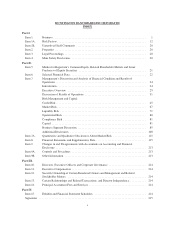Huntington National Bank 2011 Annual Report Download - page 20
Download and view the complete annual report
Please find page 20 of the 2011 Huntington National Bank annual report below. You can navigate through the pages in the report by either clicking on the pages listed below, or by using the keyword search tool below to find specific information within the annual report.The regulatory capital rules indicate that common stockholders’ equity should be the dominant element
within Tier 1 capital and that banking organizations should avoid overreliance on non-common equity elements.
Under the Dodd-Frank Act, the ratio of Tier 1 common equity to risk-weighted assets became significant as a
measurement of the predominance of common equity in Tier 1 capital and an indication of the quality of capital.
There is currently no mandated minimum for the Tier 1 common risk-based capital ratio.
We are required to submit a resolution plan to the Federal Reserve and the FDIC.
The Federal Reserve and FDIC have issued final regulations as required by section 165 of the Dodd-Frank
Act regarding resolution plans, also referred to as “living wills.” The Federal Reserve and FDIC issued final rules
applicable to bank holding companies with assets of $50 billion or more, which became effective November 30,
2011. The FDIC issued final rules applicable to insured depository institutions with assets of $50 billion or more,
which will become effective April 1, 2012. Insured depository institutions with $50 billion or more in total
assets, like us, must submit to the FDIC a plan whereby the institution can be resolved by the FDIC, in the event
of failure, in a manner that ensures depositors will receive access to insured funds within the required timeframes
and generally ensures an orderly liquidation of the institution. Additionally, bank holding companies, like us,
with assets of $50 billion or more are required to submit to the Federal Reserve and the FDIC a plan that, in the
event of material financial distress or failure, establishes the rapid and orderly liquidation of the company under
the bankruptcy code and in a way that would not pose systemic risk to the financial system of the United States.
The regulations allow for a tiered approach for complying with the requirements based on materiality of the
institution. Currently, we are required to submit resolution plans as prescribed by December 31, 2013.
Rules have been proposed to implement the Volcker Rule.
In October 2011, the Federal Reserve issued proposed rules to implement the “Volcker Rule” required by
the Dodd-Frank Act. The Volcker Rule prohibits an insured depository institution and its affiliates from:
(i) engaging in “proprietary trading” and (ii) investing in or sponsoring certain types of funds (“covered funds”)
subject to certain limited exceptions. These prohibitions are expected to impact the ability of U.S. banking
organizations to provide investment management products and services that are competitive with nonbanking
firms generally and with non-U.S. banking organizations in overseas markets. The proposed rules would also
effectively prohibit short-term trading strategies by any U.S. banking organization if those strategies involve
instruments other than those specifically permitted for trading. We do not anticipate that impacts of the proposed
rules will be material to our results of operations or financial position.
Compliance with Regulation E has reduced our revenues.
In November 2009, the Federal Reserve Board amended Regulation E under the Electronic Fund Transfer
Act to prohibit banks from charging overdraft fees for ATM or point-of-sale debit card transactions that
overdrew the account unless customers opt-in to the discretionary overdraft service and to require banks to
explain the terms of their overdraft services and their fees for the services (Regulation E Amendment).
Compliance with the Regulation E Amendment was required by July 1, 2010. We complied with the Regulation
E Amendment by alerting our customers that we no longer cover such overdrafts unless they opt-in to our
overdraft service and disclosed the terms of our service and our fees for the service.
The rules effecting debit card interchange fees under the Durbin Amendment, which became effective on
October 1, 2011, have negatively impacted our electronic banking income.
The Durbin Amendment required the Federal Reserve to establish a cap on the rate merchants pay banks for
electronic clearing of debit transactions (i.e. the interchange rate). The Federal Reserve issued final rules,
effective October 1, 2011, for establishing standards, including a cap, for debit card interchange fees and
prohibiting network exclusivity arrangements and routing restrictions. The final rule established standards for
assessing whether debit card interchange fees received by debit card issuers were reasonable and proportional to
the costs incurred by issuers for electronic debit transactions. Under the final rule, the maximum permissible
6
























